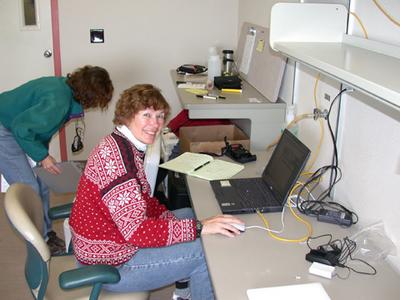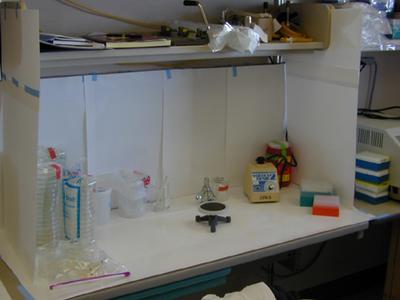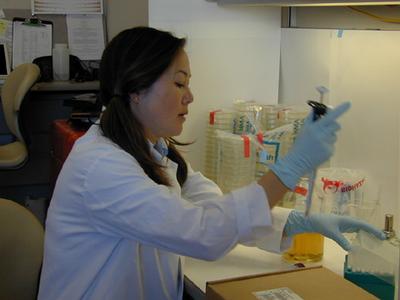8 December, 2002
Setting Up the Lab
Setting up the lab is a fun activity. When we are ready, the research team is
given a lab for the duration of their stay. The lab is empty and has a great
view of the Royal Society Mountain Range.
What do you think we need to do to get the lab up and going? Share some ideas
with your friends before reading about what we actually did.
The system established here at the Crary lab involved submitting a list of
equipment and chemicals that we anticipate needing for our research. The
support people make sure all of the items are available. It is our job to go to
the equipment and supply room and sign out everything that we need. This takes
most of a day by the time we find all of the materials and equipment. For the
chemicals, we need to label every item with our event number. We also add the
date for when each bottle is opened. We need to decide where to put everything
so that it is convenient for use.
One of the first things we do is to wipe down all the surfaces of the lab.
There is a lot of dust here and we will be working with growth media for yeast.
Bacteria would love to grow in our media, so we want to keep the lab as clean
as possible. Next we decide what processes will be done where in the lab. We
need to filter samples, bake samples, incubate, extract DNA, make growth media,
check pH of various solutions we will be making, autoclave glassware and growth
media for the yeast, and keep track of everything. We also need to make sure
all of the instruments work. We will need a pH meter, an incubator, an oven,
and other items that we need to calibrate and make sure the dials accurately
measure temperature.
Dr. Redman sets up some work spaces that will be as clean as she can make them.
She knows from experience that taking time now will same time later on.

Setting up the computer Barb is setting up the computer connections to send e-mail entries from the lab. Soon we start organizing the lab and the computer work will happen in teh office next door.

Arranging the lab and labeling the chemicals is an important part of doing science. Since we are working with microorganisms, we want to keep the lab as clean as possible.

Setting up the filtering equipment requires testing of the vacuum system. Note the white paper hung around the filters to protect the system from breeze in the room. This is a precaution that makes it easier to control unwanted bacterial growth.

Regina Redman is pipetting some autoclaved growth media into the small plates in preparation for the samples we will work with later. Before we start filtering samples, everything must be ready and in good working order. We have 48 samples from the first transect from the Taylor Valley

Autoclaving materials. It is important to steralize all of our materials. Here Regina Redman is preparing some equipment for the autoclave. We will autoclave the equipment for 30 minutes. The autoclave is in another lab that is shared by everryone. Once everything is ready, we can begin working with the samples.

Preparing the plates here. Regina has set up a clean space here for us to pour sterile media into the growth plates . We will filter samples and place the filters in the media plates. We hope that if there are any yeast in the soil, we will catch them on the filter and that they will grow in the plates when given food and a nice cool place to grow. Do you think we will find any yeast from the samples?
Contact the TEA in the field at
.
If you cannot connect through your browser, copy the
TEA's e-mail address in the "To:" line of
your favorite e-mail package.
|
